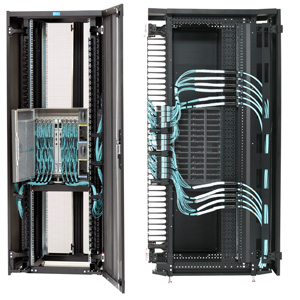CPI’s Brian Donowho, along with Corning Cable Systems’ Alan Ugolini, wrote an article that was recently published in Business Management Magazine titled “Streamlining the Data Center with High-Density Cabling Solutions”. The article describes the dynamics of the enterprise data center and the need to reduce operating costs while increasing performance. It further explains the importance of seamlessly integrating new technology deployments that are low risk, simple and easy to maintain as well as the hazards of traditional cabling.
"Traditional optical cabling solutions such as duplexed patch cords and duplexed connector assemblies work well in application-specific, low-port-count environments. But as port counts scale upwards and system equipment turnover accelerates, these solutions become unmanageable and unreliable. Also, new cabling may be pulled over decommissioned existing cable … can lead to data center reliability issues, as cable build-up in cabinets, pathways and spaces, blocks air circulation and creates hot spots. Operational cost can increase in managing this unused cabling. Networking complexity increases as channel identification becomes difficult and port utilization at the patch panel decreases."
 The article goes into detail about the benefits of a modular, high-density MTP-based structured wired cabling system. Though not specifically named in the article, the product recommended by both CPI and Corning is CPI's Fiber Management Solution for TeraFrame Cabinets which was developed through a partnership between these two companies.
The article goes into detail about the benefits of a modular, high-density MTP-based structured wired cabling system. Though not specifically named in the article, the product recommended by both CPI and Corning is CPI's Fiber Management Solution for TeraFrame Cabinets which was developed through a partnership between these two companies.
Features and benefits of high-density cabling solutions include:
- Zero-u space connectivity that maximizes the rack unit space available for data center electronics
- Innovative port mapping architecture from the main distribution area to the SAN Director, reducing infrastructure design and installation time
- Customized transition assemblies that attach to the high-density MTP backbone cabling infrastructure that simplify and improve initial speed of deployment and future MACs as well as promote airflow efficiency within the cabinet
- Full integration of the backbone MTP cable assemblies into the cabinet providing a streamlined approach to deploying and organizing trunk cabling in the data center
- A bulk cabling reduction in the cabinet vertical manager and SAN Director backplane of over 77 percent versus traditional patch cord cabling solutions
- Highly modular system that can be easily reconfigured to meet future data center networking requirement
I believe you will find the article to be full of useful information that will help you achieve both your business and technology goals. You can download the entire article or read it on the Business Management Website. Kim Ream, eMarketing Designer